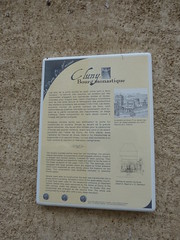Porte d'Honneur
Commemorated on 1 plaque
Le Porte d'Honneur Les arcs de la porte double en plein cintre sont à deux rouleaux ; le second, très mouluré, est soutenu par des colonnettes engagées aux cannelures droites et torses, inversées pour chaque baie. Leurs chapiteaux corinthiens sont de très belle facture et témoignent des productions des meilleurs sculpteurs des années 1120-1130. Les baies, autrefois munies de grands vantaux de bois, sont cantonnées de pilastres cannelés des maçonneries, un étage d'attique. Cette composition fut sans doute voulue à l'image des portes antiques. Quelques années après son édification la porte fut transformée en porterie. Située au devant de la grande église abbatiale, elle devait être utilisée pour le cérémonial d'entrée des grands visteurs, avant que ceux-ci ne soient accueillis par l'abbé de Cluny. Au XVIe siècle, sous l'abbatiat de Claude de Guise, celle-ci fut transformée et augmentée d'un second niveau. Le tout était surmonté d'un haut comble en pavillon à l'élévation vertigneuse.
English translation: The Gate of Honour The arches of the semi-circular double door are double-roll; The second, very molded, is supported by pillars engaged with straight and twisted flutes, reversed for each bay. Their Corinthian capitals are very beautiful and testify to the productions of the best sculptors of the years 1120-1130. The bays, formerly equipped with large wooden panels, are lined with fluted pilasters of masonry, an attic storey. This composition was undoubtedly wanted in the image of the ancient gates. A few years after its construction, the door was transformed into a door. Located in front of the large abbey church, it was to be used for the ceremonial entrance of the great visitors, before they were welcomed by the abbot of Cluny. In the sixteenth century, under the abbey of Claude de Guise, it was transformed and augmented by a second level. The whole was surmounted by a high roof in pavilion at the vertiginous elevation.
Rue de l'Abbatiale, Cluny, France where it sited

